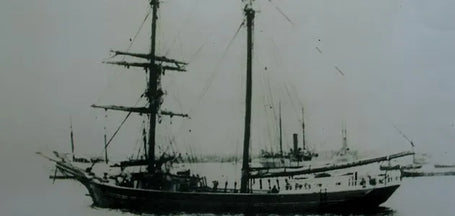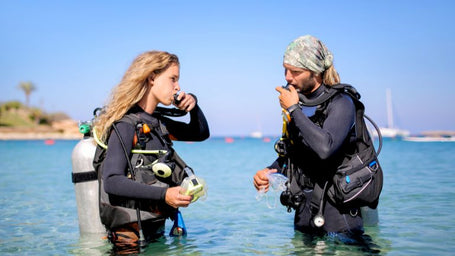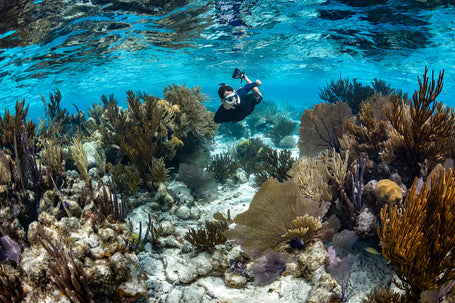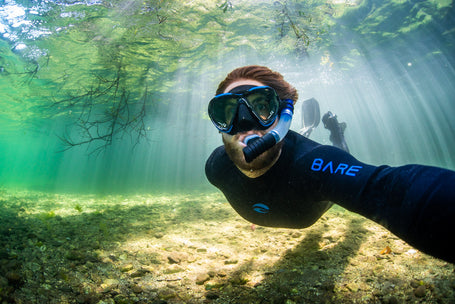Are you eager to dive into a truly spine-chilling adventure this Halloween? Travel to these haunted underwater locations and immerse yourself in the eerie world of ghostly shipwrecks and hauntingly beautiful underwater caverns. Remember, these Halloween dive sites are not for the faint-hearted.
The Haunted Shipwrecks of the Deep
Diving into the deep, you will come across secrets from the past, frozen in time and preserved by the sea's hold. These underwater graveyards known as shipwrecks turn into haunted arenas around Halloween. Home to many tragic tales, the sight of these eerie remains can make even the bravest divers' blood run cold.
The Ghost Ship: Exploring the Legends of the SS Yongala

The SS Yongala, an opulent passenger ship, rests off the coast of Queensland, Australia. Its story is every sailor's nightmare - it sank during a cyclone in 1911, with no survivors from the 122 onboard. The ship was considered the most luxurious vessel of its time, and its tragic ending has created a wraith-like atmosphere around it. As you explore the wreck, you can sense the heavy feeling of resting spirits:
- Spot perfectly preserved fittings and grand remnants of its erstwhile glory.
- Be intrigued by the marine life that now inhabits the wreckage. Brightly colored corals, huge trevallies, even bull sharks have made this underwater tomb their home.
- Feel a shiver down your spine as you swim among the once lively grand saloon and decks, now ethereal stages for the ghostly theater.
The Wreck of the Mary Celeste: A Haunting Dive in the Caribbean

Our next stop takes us to the enigmatic wreck of the Mary Celeste. The ship, found abandoned off the coast of Portugal in 1872, perplexed marine investigators - her crew vanished without a trace, leaving behind untouched food and personal belongings. The truth remains buried in the sea with the ship:
- Get the chills as you dive into a mystery that decades of research and theories haven't solved.
- Marvel at the surreal beauty as soft corals and sea sponges flicker like ghostly candles in the wreck.
- Encounter marine life that has made this enigma their abode, adding to the uncanny ambiance.
Embrace the chill of these tales of lost souls as the saltwater around you turns just a tad more frigid. What's Halloween without a bit of the unexplained and the hauntingly beautiful?
Mysterious Underwater Caves and Abysses
Adventure begins where the daylight ends, and there's no better place to begin your Halloween underwater adventure than the mysterious caves and abysses that plunge into the dark depths of our planet's oceans. Here's our pick of the most bone-chilling dungeons.
The Blue Hole: Delving into the Depths of the Great Blue

One of the eeriest spots is the ominous "Blue Hole" in Belize. This daunting underwater sinkhole is not meant for the faint of heart. It’s about 1,000 feet across and 400 feet deep, making it the largest of its kind. Its depth is veiled in darkness and the lack of light is enough to incite a bone-chilling sensation.
Moreover, the peculiar stalactites found deep inside suggest that this part was once above sea level over thousands of years ago. All of this, coupled with the eerie calmness of the water and the strange aquatic creatures you might encounter, makes the Blue Hole a chilling yet intriguing diving site for Halloween.
The Devil's Eye: Unveiling the Secrets of Florida's Underwater Caverns

Next on the list is the aptly named "Devil's Eye," part of Florida's underwater caves system. Beneath the murky depths lie intricate caverns, passages, and tunnels that give off a ghostly vibe.
• As you dive further, you'll experience colder temperatures and dark, narrow passageways mysteriously illuminated by soft beams of light.
• Expect to encounter ancient fossils embedded in the cavern walls and various species of creepy-crawlies.
• A strong sense of foreboding often engulfs divers as they traverse the eerie, silent labyrinth.
Despite its spooky ambiance, the Devil's Eye offers a unique glimpse into a hidden world beneath the surface, making it a must-visit site this Halloween.
The Cenote of Sacrifices: Diving into the Mysteries of the Mayan Underworld

Finally, we wander to Mexico's Yucatan Peninsula to unearth the secrets of the 'Cenote of Sacrifices.' This cavernous pit was once used by the Mayans for human sacrifices to appease their Gods.
• Divers can uncover ancient skeletal remains and other eerie artifacts in its depths.
• Getting into the water itself feels like trespassing into another realm, adding to the overall spookiness.
Delving into these sacred and sinister waters may not be for everyone. However, those who dare usually emerge with tales of an unforgettable journey deep into the mysteries of the Mayan underworld. Dare you take the plunge this Halloween?
Haunted Diving Spots Around the World
The underwater world is filled with as much mystery and intrigue as the world above. If the idea of exploring chilling depths teeming with ghostly shipwrecks and secret, submerged cities piques your interest, embrace the thrill of these haunted dives.
Shipwrecks Cemetery: Haunted Dive Sites in the Great Lakes

Start your spooky underwater adventure in the Great Lakes, often referred to as the "Shipwreck Cemetery." A watery grave for more than 6,000 shipwrecks, many believe the lake waters harbor not only remnants of the sunken vessels, but the spirits of those who went down with them. Descend into the chilly waters to explore the shipwrecks from centuries past — every rusty hull or weathered wooden panel tells a different story. Get a surreal experience when you:
* Dive into Lake Superior and visit the SS Kamloops, where, according to anecdotal accounts, the ghost of a sailor can still be seen, earnestly unloading his cargo.
* Explore the wreck of SS Regina in Lake Huron. It sank in a snowstorm in 1913 and many divers claim to feel a palpable sense of foreboding when in its vicinity.
The Ghostly Waters of Truk Lagoon

Truk Lagoon, in the Pacific Ocean's heart, offers divers one of the most eerie Halloween experiences. This tranquil Micronesian lagoon hides a grim past, as a major ship graveyard from World War II. Around 60 sunken Japanese vessels rest in its murky waters, along with countless planes. Divers often report the sensation of being watched and an eerie quietness that seems to swallow all other sounds, making for an otherworldly experience. Some highlights include:
* Exploring the ghostly fleet in deep silence, seeing the remnants of the past studded with bullet holes and encrusted with coral.
* The haunting encounter with skeletal remains, still trapped within the remnants of their sunken craft.
The Lost City of Atlantis: Myths and Dive Adventures in Santorini

Lastly, we venture to Greece, to the islands of Santorini. Linked with the legend of Atlantis, the lost city submerged in water, diving here is nothing less than thrilling. With the ancient volcanic structures, underwater geological formations bear traces of arguably the greatest myth in history. Diving into these depths, adventurers -
* Can watch the underwater ruins which some believe are remnants of the Atlantis civilization.
* Will encounter the eeriness of the unseen past with every swim stroke.
Whether you're into ghost stories, ancient myths, or just enjoy the adrenaline rush of exploring the unknown, these dive sites will ensure a hauntingly exciting adventure this Halloween.
Spooky Encounters Underwater
Ready to turn your Halloween into a thrilling, underwater adventure? Here are some dive sites known not only for their beauty but for the chilling experiences that are sure to give you goosebumps - or should we say fishbumps?
The Ghostly Ballet: Diving with Manta Rays at Night

First on our list is the mysterious spectacle that is known as the Ghostly Ballet: night diving with manta rays in Kona, Hawaii. As you plunge into the depths after sunset, you'll await the spectacle in the low light conditions, with only your dive lights illuminating the surrounding ocean. Suddenly, the quiet waters start buzzing with activity as sinuous shapes glide into the light- it's the manta rays! Swirling around you in a beautiful, ghostly ballet, these gentle giants, with wing spans that can reach up to 20 feet, feed on the plankton attracted by your dive light. While it's utterly mesmerizing, there's an undeniably eerie feeling as you watch these alien-like creatures emerge from the darkness.
The Phantom Fish: Meeting the Goliath Grouper

Next, we dive into the lairs of the phantom fish, the Goliath grouper. Selected dive sites off the coast of Florida offer this Halloween-worthy experience. These massive sea-dwelling creatures can weigh up to 800 pounds and although they have a docile demeanor, their sheer size and hovering presence can be quite intimidating.
- Encounter them at wrecks and artificial reefs.
- Late summer is the best occasion when groups of Goliath groupers gather to mate.
- Be ready for their deep, resonating “boom” sounds that magnify eerily underwater.
- They tend to come close and inspect divers, adding to the thrilling encounter.
Whether you're dancing in the dark with mantas or having a close encounter with a giant fish species, diving offers some unique opportunities to amplify your Halloween thrill. Stay tuned as we unearth more spine-chilling underwater experiences.
Safety Tips for Diving in Haunted Locations
Venturing into the uncanny depths of haunted underwater locations calls for a specific set of safety measures. The thrill of experiencing something different is a significant draw for many, but let's ensure your creepy underwater adventures don't turn into freaky mishaps.
Dive Buddies: The Importance of Sticking Together in Eerie Waters
The first rule when diving, especially in spooky locations, is never dive alone. Having a dive buddy can make all the difference during your underwater escapade. It's even more critical when you're weaving through a haunting shipwreck or cryptic underwater cave on Halloween night. Your dive buddies can:
• Help keep emotions in check. The sight of eery shadows or strange sounds can send a chill right up your spine, but knowing you're not alone offers emotional reassurance.
• Provide lifesaving support in case of emergencies. If something goes wrong under the water, a buddy can offer immediate assistance.
• Serve as a double-check for safety measures. From equipment to navigation, two heads are always better than one!
Equipment Check: Ensuring a Terrifyingly Safe Dive
When diving into the dark corners of the underwater world, you want to make sure your equipment is reliable. It's not just to enhance your 'diving on Halloween' experience but to ensure your safety during the dive.
• Always perform your buddy checks to make sure your gear is ready to dive.
• Don’t forget to check your flashlight; the shadows in an underwater cave or shipwreck can be bone-chillingly dark.
• Always dive with the appopriate safety equipment - whether lights, safety sausages, or knives, small things can help you in a unexpected situation.
Remember, safety should always be your top priority. Haunted underwater locations can be full of surprises, and taking precautions will go a long way in ensuring that your dive is fun, adventurous, and, most importantly, safe.
Diving on Halloween promises a creepy yet intriguing underwater experience unlike any other. Make sure to pack your scuba gear...and perhaps, your ghost-busting tools as well. Happy Haunting!















